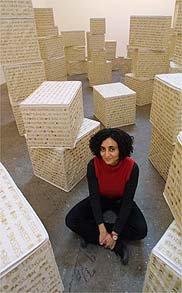Ghada Amer

via UNC Chapel Hill
apropo of Lee Siegel discussing MoMA’s current show about contemporary Islamic art*, I thought I’d mention one of the exhibitors, Ghada Amer.
from UNC's “women voices in the franco arabic world:”
Ghada Amer, a 38-year-old Egyptian-born artist who lived in France from the age of 11 and moved to Manhattan four years ago.[c.2001- JV](*like Siegel I also wish the MoMA didn’t concentrate so heavily on expatriates, but what are you gonna do...)
Ms. Amer, who received a master's degree in painting at L'École des Beaux-Arts in Nice, found her artistic direction after a visit to her parents in Cairo in 1988. There, she saw how pervasively the veil had been adopted again, hiding the reality of Egyptian women as she knew it. She was particularly stunned, she says, by a fashion magazine featuring sewing patterns called "Venus," which she felt ludicrously superimposed Egyptian veils and hats and long sleeves on Western fashions.
[...]
... Ms. Amer uses passages from an 11th-century book written by a Muslim man titled the "Encyclopedia of Pleasure." In the book he earnestly tries to catalog, scientifically, all aspects of sexual pleasure for both men and women.
On the 57 boxes stacked and scattered around the gallery like moving crates — summoning the idea of leaving an old home for a new one — Ms. Amer fitted canvas slipcovers embroidered with sections from the encyclopedia pertaining to women, including her favorite chapter, "On the Advantages of a Nonvirgin Over a Virgin."
"What I find so fantastic about this book is that it's profoundly religious," Ms. Amer says, explaining that it was written during a flourishing intellectual period in Islam but that it has long been a forbidden text. Indeed, the only evidence of its existence is a poor English translation written as a doctoral dissertation and never published. "It's not that the author wanted to make a revolution," she says. "It's that he wanted to be a better Muslim by being a better sexual being. I copied it as a way of preserving it, as proof of something that is very different from now."
[...]
While Ms. Amer's parents are progressive in some ways — choosing to educate her and her three sisters in France, for instance — they are strictly religious and have had to get used to their daughter's choice to be an artist, particularly one dealing with the taboo subject of sexuality. Ms. Amer recounts a story about her traditionally veiled cousin, whom she first hired five years ago to help with the time-consuming embroidery.
"In the beginning, she thought that a sex shop had commissioned this," Ms. Amer says with amusement. "I gave her a catalog and tried to explain to her what I was doing. Now, she's the one who explains it to other people. I never believed that art had the possibility of changing the world. Maybe now I believe it a little bit.





<< Home